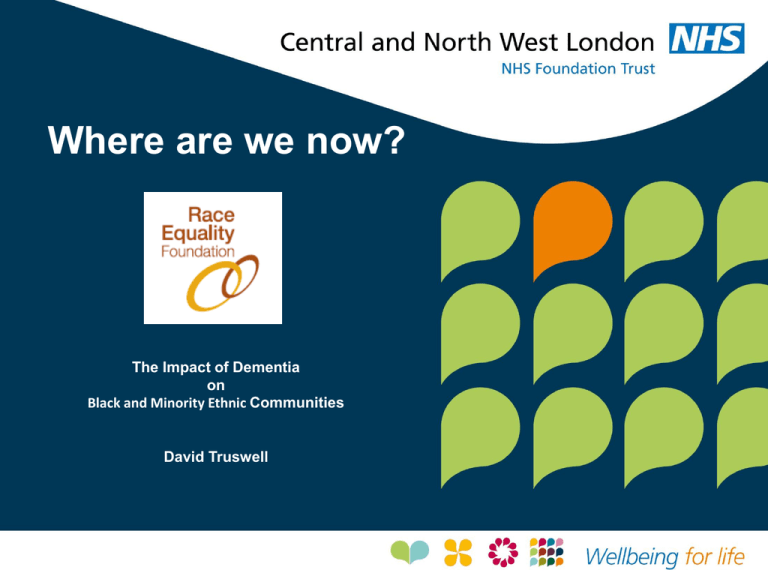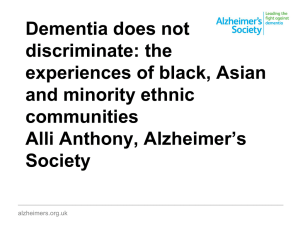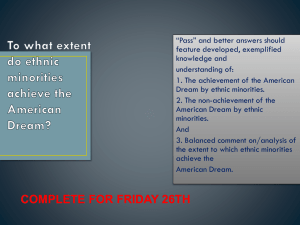David-Truswell
advertisement

Where are we now? The Impact of Dementia on Black and Minority Ethnic Communities David Truswell Black and Minority Ethnic Communities and Dementia Briefing Paper published in November 2013 Dementia is recognised as a worldwide health priority but research on dementia in general is poorly funded. Implementing the National Dementia Strategy should take into account the information and support needs of black and minority ethnic communities The prevalence of dementia in black and minority ethnic communities in the UK has been significantly underestimated Dementia is misunderstood and highly stigmatised in many UK black and minority ethnic communities There is an economic case for financing improvements in ‘living well’ with dementia for people in black and minority ethnic communities Estimated Dementia prevalence for England and Wales black and minority ethnic population (2011 Census) all those over 65 Estimated Dementia prevalence for England and Wales black and minority ethnic population (2011 Census) all those over 65 by age cohort Why is this a particular concern for black and minority ethnic communities? 1. There will be a XX fold increase in BME communities over the next X years 2. Within these broad trends there is projected to be a substantial increase of older people in some black and minority ethnic populations, notably the Irish, Indian and AfricanCaribbean populations, reflecting historic migration patterns 3. Lack of awareness as well as social and cultural factors reduce help seeking behaviours in black and minority ethnic populations, especially for mental health problems 4. There is an expectation of discrimination and/or lack of cultural competence from mental health services by black and minority ethnic populations 5. There are known predisposing health factors e.g. South Asian and African Caribbean groups are at increased risk of developing vascular dementia - the second most common form of the dementia - due to enhanced levels of diabetes and hypertension 6. Professionals’ assumptions about lifestyle and care giving cultural norms of black and minority ethnic communities may inhibit help-giving behaviour 7. Use of appropriately standardised diagnostic tools in assessments needs to be considered Why is this a particular concern for black and minority ethnic communities? 1. There will be a seven fold increase in dementia BME communities over the next 30 years compared with a two fold increase in the indigenous White population 2. Within these broad trends there is projected to be a substantial increase of older people in some black and minority ethnic populations, notably the Irish, Indian and AfricanCaribbean populations, reflecting historic migration patterns 3. Lack of awareness as well as social and cultural factors reduce help seeking behaviours in black and minority ethnic populations, especially for mental health problems 4. There is an expectation of discrimination and/or lack of cultural competence from mental health services by black and minority ethnic populations 5. There are known predisposing health factors e.g. South Asian and African Caribbean groups are at increased risk of developing vascular dementia - the second most common form of the dementia - due to enhanced levels of diabetes and hypertension 6. Professionals’ assumptions about lifestyle and care giving cultural norms of black and minority ethnic communities may inhibit help-giving behaviour 7. Use of appropriately standardised diagnostic tools in assessments needs to be considered Community Engagement Information Access to Services & Support Stigma What does this mean for individual families? Carer has health crisis Family member with increasing memory loss & erratic behaviour Increased carer burden & isolation Impact of stigma and lack of information Carer unable to continue with care CRISIS POINT No suitable home based care can be provided Patient Person living with dementia has health crisis Hospital Admission Residential Care Admission The key focuses of the Prime Minister's challenge are: Improved diagnosis better support for carers dementia friendly communities improved research What could a culturally informed care pathway look like? GP confidence in availability of appropriate postdiagnostic support Understanding within BME Communities Family member with increasing memory loss & erratic behaviour Approach GP with concerns Information themed for BME Communities Carer understanding from BME Communities Early Diagnosis by Memory Service Appropriate peer support & community participation Advance Directives and community based support Held in Community & Family Memory Spiritual preparation Advanced stage and end-of-life care Consistent culturally informed support from care professionals System wide benefits of improving focus on black and minority ethnic groups Use of Community Services A & E access Rate of access to Residential Care Use of In-patient Services Carer Use of Health Services Some current good practice examples Alzheimer's Society – Connecting Communities Initiative in London & developing information for South Asian Communities nationwide Meri Yaadain is an information and advice service for the South Asian communities in Bradford Developing a BME focus within Dementia Action Alliance Culture Dementia UK is an energetic 3rd organisation that has been working in Brent for the past 15 years with the African-Caribbean Admiral Nurses - Tom’s Club an other London initiatives. Dementia UK’s Admiral Nurses in London have extensive experience and knowledge in support black and minority ethnic carers Asian link worker, in Wolverhampton where a community nurse fluent in Punjabi and English provides an outreach role to local South Asian communities Policy influencing organisations - Age UK, Race Equality Foundation ,The Policy Institute for Research on Ageing and Ethnicity (PRIAE) Developing online resources (Facebook, Linked-In Group, Yecco) Developing more research focus on ageing in black and minority ethnic communities (ESRC Seminar Series 2012-2014: Ageing, Race & Ethnicity) An ‘invest to save’ illustration for using cost saving benefits of delayed transfer to residential home to fund community support services PSSRU Provider category Cost per resident per week Cost per resident per day Cost saving per week for 100 cases by 1week delay in transfer Less cost of 1 week of Social Care Package Critical care package costs £363 per person per week Private sector nursing homes for older people £736 £105.14 £73,600 Less cost of Critical care - saves £37,300 per 100 cases per week Private sector residential care for older people £522 £74.57 £52,200 Less cost of Critical care - saves £15,900 per 100 cases per week Local authority residential care for older people £1,007 £143.86 £100,700 Less cost of Critical care - saves £64,400 per 100 cases per week Extra care housing for older people £428 £61.14 £42,800 Less cost of Critical care - saves £6,500 per 100 cases per week Voluntary adult befriending £87 for 12 hrs per week Targeted black and minority ethnic health promotion campaign Unknown as depends on the scale of health promotion campaign Costing for early interventions This could support development of 'black and minority ethnic dementia navigator' This could be partly directly invested in black and minority ethnic community groups. It is anticipated that economic benefits would be comparable with those found by Knapp et al.* in reviewing the benefits of mental health promotion *Mental health promotion and mental illness prevention: The economic case (2011) Knapp M., McDaidand D. and Parsonage M. (eds.) Personal Social Services Research Unit, London School of Economics and Political Science Contact Details David Truswell Senior Project Manager, CNWL david.truswell@nhs.net Mobile: 07969 692315 or via Linked-In








